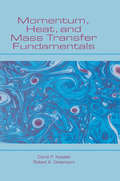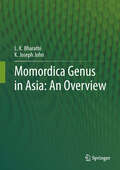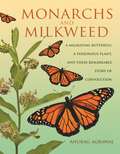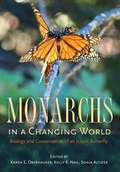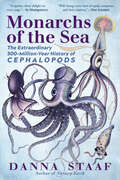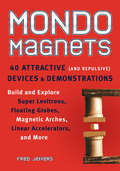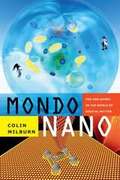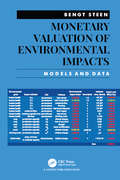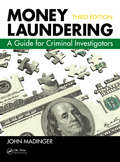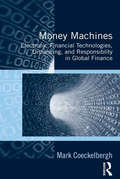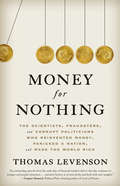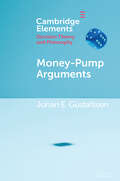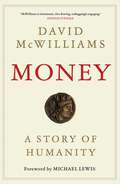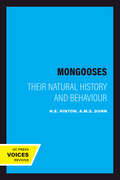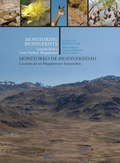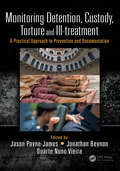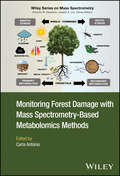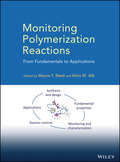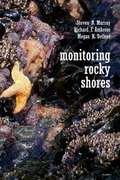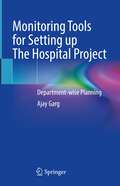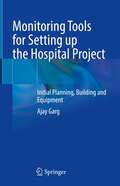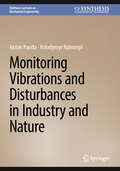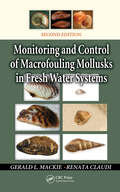- Table View
- List View
Momentum, Heat, and Mass Transfer Fundamentals
by David P. Kessler Robert A. Greenkorn"Presents the fundamentals of momentum, heat, and mass transfer from both a microscopic and a macroscopic perspective. Features a large number of idealized and real-world examples that we worked out in detail."
Momordica genus in Asia - An Overview
by L. K. Bharathi K Joseph JohnAsiatic Momordica comprises 10 species of which 3 are monoecious and rest dioecious. They are unique in the sense that all are wild or cultivated vegetables with medicinal uses. Barring bitter gourd, all are under utilized vegetables with little research and conservation efforts. In this book, the authors have presented the available information on various aspects of Asiatic Momordica like taxonomy, cytogenetics, crop improvement, origin, ethnobotany and crop production at one place. The book is well illustrated with color maps and photographs depicting habit, morphology and distribution of individual taxa. Species distribution map for all Indian taxa, descriptor for characterization and preliminary evaluation of dioecious and monoecious group available varieties, keys for botanical identification are some of the unique features of the book. The book will be useful to botanists, horticulturists, foresters, environment educators, conservation biologists, plant science students in general and all interested in agrobiodiversity.
Monarch Butterfly (Live Oak Media Ereadalong Ser.)
by Gail GibbonsIntroduce young readers to the fascinating process of how catepillars become butterflies. Follow the transformation from a tiny white egg laid on a leaf to a brilliantly colored butterfly in this kid-friendly introduction to metamorphosis. With detailed, bright watercolors, Gail Gibbons illustrates the life cycle of the monarch butterfly, stage by stage, as it grows, changes, and takes flight. With clear, labeled diagrams and simple text that defines and reinforces important vocabulary, Monarch Butterfly introduces key concepts of insect anatomy and behavior. And of course, the unique migration of the monarch-- which can range up to four thousand miles-- is covered, with descriptions of how the insects travel, and how people in their path celebrate the occasion. This classic look at butterflies also includes directions on raising your own monarch at home, and a page of fun facts about these colorful butterflies.
Monarchs and Milkweed: A Migrating Butterfly, a Poisonous Plant, and Their Remarkable Story of Coevolution
by Anurag AgrawalThe fascinating and complex evolutionary relationship of the monarch butterfly and the milkweed plantMonarch butterflies are one of nature's most recognizable creatures, known for their bright colors and epic annual migration from the United States and Canada to Mexico. Yet there is much more to the monarch than its distinctive presence and mythic journeying. In Monarchs and Milkweed, Anurag Agrawal presents a vivid investigation into how the monarch butterfly has evolved closely alongside the milkweed—a toxic plant named for the sticky white substance emitted when its leaves are damaged—and how this inextricable and intimate relationship has been like an arms race over the millennia, a battle of exploitation and defense between two fascinating species.The monarch life cycle begins each spring when it deposits eggs on milkweed leaves. But this dependency of monarchs on milkweeds as food is not reciprocated, and milkweeds do all they can to poison or thwart the young monarchs. Agrawal delves into major scientific discoveries, including his own pioneering research, and traces how plant poisons have not only shaped monarch-milkweed interactions but have also been culturally important for centuries. Agrawal presents current ideas regarding the recent decline in monarch populations, including habitat destruction, increased winter storms, and lack of milkweed—the last one a theory that the author rejects. He evaluates the current sustainability of monarchs and reveals a novel explanation for their plummeting numbers.Lavishly illustrated with more than eighty color photos and images, Monarchs and Milkweed takes readers on an unforgettable exploration of one of nature's most important and sophisticated evolutionary relationships.
Monarchs in a Changing World: Biology and Conservation of an Iconic Butterfly
by Kelly R. Nail Karen S. Oberhauser Sonia AltizerMonarch butterflies are among the most popular insect species in the world and are an icon for conservation groups and environmental education programs. Monarch caterpillars and adults are easily recognizable as welcome visitors to gardens in North America and beyond, and their spectacular migration in eastern North America (from breeding locations in Canada and the United States to overwintering sites in Mexico) has captured the imagination of the public.Monarch migration, behavior, and chemical ecology have been studied for decades. Yet many aspects of monarch biology have come to light in only the past few years. These aspects include questions regarding large-scale trends in monarch population sizes, monarch interactions with pathogens and insect predators, and monarch molecular genetics and large-scale evolution. A growing number of current research findings build on the observations of citizen scientists, who monitor monarch migration, reproduction, survival, and disease. Monarchs face new threats from humans as they navigate a changing landscape marked by deforestation, pesticides, genetically modified crops, and a changing climate, all of which place the future of monarchs and their amazing migration in peril. To meet the demand for a timely synthesis of monarch biology, conservation and outreach, Monarchs in a Changing World summarizes recent developments in scientific research, highlights challenges and responses to threats to monarch conservation, and showcases the many ways that monarchs are used in citizen science programs, outreach, and education. It examines issues pertaining to the eastern and western North American migratory populations, as well as to monarchs in South America, the Pacific and Caribbean Islands, and Europe. The target audience includes entomologists, population biologists, conservation policymakers, and K-12 teachers.
Monarchs of the Sea: The Extraordinary 500-million-year History Of Cephalopods
by Danna StaafFrom the author of Nursery Earth, a “nimble, fast, surprising, smart, and weird in the very coolest sense of the word” (Sy Montgomery) exploration of the sometimes enormous, often bizarre creatures that ruled the seas long before the first dinosaurs—a Science Friday Book Club Pick Cephalopods, Earth’s first truly substantial animals, are still among us: Their fascinating family tree features squid, octopuses, nautiluses, and more. The inventors of swimming, cephs presided over the sea for millions of years. But when fish evolved jaws, cephs had to step up their game (or end up on the menu). Some evolved defensive spines. Others abandoned their shells entirely, opening the floodgates for a tidal wave of innovation: masterful camouflage, fin-supplemented jet propulsion, and intelligence we’ve yet to fully measure. In Monarchs of the Sea, marine biologist Danna Staaf unspools how these otherworldly creatures once ruled the deep—and why they still captivate us today. Publisher’s Note: Monarchs of the Sea was previously published in hardcover as Squid Empire.
Mondo Magnets: 40 Attractive (and Repulsive) Devices and Demonstrations
by Fred JeffersSurprising and seemingly impossible effects result from the 40 experiments included in this fascinating science resource--all based on real magnetic physics. Each experiment--such as using a common refrigerator magnet to create a three-dimensional image or floating a magnet and carbon sheet in midair--is outlined with step-by-step instructions and diagrams that illustrate the key concepts of magnetism. Even the most experienced science teacher or at-home tinkerer will find dozens of new tricks in this amazing collection.
Mondo Nano: Fun and Games in the World of Digital Matter
by Colin MilburnIn Mondo Nano Colin Milburn takes his readers on a playful expedition through the emerging landscape of nanotechnology, offering a light-hearted yet critical account of our high-tech world of fun and games. This expedition ventures into discussions of the first nanocars, the popular video games Second Life, Crysis, and BioShock, international nanosoccer tournaments, and utopian nano cities. Along the way, Milburn shows how the methods, dispositions, and goals of nanotechnology research converge with video game culture. With an emphasis on play, scientists and gamers alike are building a new world atom by atom, transforming scientific speculations and video game fantasies into reality. Milburn suggests that the closing of the gap between bits and atoms entices scientists, geeks, and gamers to dream of a completely programmable future. Welcome to the wild world of Mondo Nano.
Monetary Valuation of Environmental Impacts: Models and Data
by Bengt SteenThe book is meant to improve our understanding of sustainable development of production and consumption. Monetary values of the impact of emission and resources are determined, and used in environmental management, with a focus on sustainability. Values related to cultural context are not possible to predict, therefore ignored. The book only focuses on environmental goods and services that are used to satisfy basic human needs. One of the benefits of monetary valuation is its holistic approach. The impact of any contributing factor on the total value, can be determined, and the sensitivity to uncertainty in inputs can be estimated. This is useful in developing knowledge, where it is most needed. In a society, there are many economic units which need to function in tandem to support human welfare. Each unit has its own system boundary in what it includes and covers in time and space. The system boundary of a sustainable unit is likely to be very long and wide. This book provides data on long term monetary values of environmental impacts from human activities. It discusses the choice of system boundaries, and how to use monetary values in sustainable development. A large part of the book describes impact models in terms of the relation between emissions and natural goods and services.
Money Laundering: A Guide for Criminal Investigators, Third Edition
by Nancy Kinnison John MadingerMany changes have occurred in the twenty-five years that have passed since the enactment of the Money Laundering Control Act of 1986. The law has been amended, new underlying crimes have been added, and court decisions have modified its scope. The Act remains an important tool in combating criminal activity. Now in its third edition, Money Launderi
Money Machines: Electronic Financial Technologies, Distancing, and Responsibility in Global Finance
by Mark CoeckelberghWhile we have become increasingly vulnerable to the ebb and flow of global finance, most of us know very little about it. This book focuses on the role of technology in global finance and reflects on the ethical and societal meaning and impact of financial information and communication technologies (ICTs). Exploring the history, metaphysics, and geography of money, algorithms, and electronic currencies, the author argues that financial ICTs contribute to impersonal, disengaged, placeless, and objectifying relations, and that in the context of globalization these 'distancing' effects render it increasingly difficult to exercise and ascribe responsibility. Caught in the currents of capital, it seems that both experts and lay people have lost control and lack sufficient knowledge of what they are doing. There is too much epistemic, social, and moral distance. At the same time, the book also shows that these electronically mediated developments do not render global finance merely 'virtual', for its technological practices remain material and place-bound, and the ethical and social vulnerabilities they create are no less real. Moreover, understood in terms of technological practices, global finance remains human through and through, and there is no technological determinism. Therefore, Money Machines also examines the ways in which contemporary techno-financial developments can be resisted or re-oriented in a morally and socially responsible direction - not without, but with technology. As such, it will appeal to philosophers and scholars across the humanities and the social sciences with interests in science and technology, finance, ethics and questions of responsibility.
Money for Nothing: The Scientists, Fraudsters, and Corrupt Politicians Who Reinvented Money, Panicked a Nation, and Made the World Rich
by Thomas LevensonThe sweeping story of how the greatest minds of the Scientific Revolution applied their new ideas to people, money, and markets—and along the way, invented modern finance. &“An astounding episode from the early days of financial markets that to this day continues to intrigue and perplex historians . . . narrative history at its best, lively and fresh with new insights.&”—Liaquat Ahamed, Pulitzer Prize–winning author of Lords of FinanceMoney for Nothing chronicles the moment when the needs of war, discoveries of natural philosophy, and ambitions of investors collided. It's about how the Scientific Revolution intertwined with finance to set England—and the world—off in an entirely new direction.At the dawn of the eighteenth century, England was running out of money due to a prolonged war with France. Parliament tried raising additional funds by selling debt to its citizens, taking in money now with the promise of interest later. It was the first permanent national debt, but still they needed more. They turned to the stock market—a relatively new invention itself—where Isaac Newton's new mathematics of change over time, which he applied to the motions of the planets and the natural world, were fast being applied to the world of money. What kind of future returns could a person expect on an investment today? The Scientific Revolution could help. In the hub of London's stock market—Exchange Alley—the South Sea Company hatched a scheme to turn pieces of the national debt into shares of company stock, and over the spring of 1720 the plan worked brilliantly. Stock prices doubled, doubled again, and then doubled once more, getting everyone in London from tradespeople to the Prince of Wales involved in money mania that consumed the people, press, and pocketbooks of the empire.Unlike science, though, with its tightly controlled experiments, the financial revolution was subject to trial and error on a grand scale, with dramatic, sometimes devastating, consequences for people's lives. With England at war and in need of funds and "stock-jobbers" looking for any opportunity to get in on the action, this new world of finance had the potential to save the nation—but only if it didn't bankrupt it first.
Money-Pump Arguments (Elements in Decision Theory and Philosophy)
by Johan E. GustafssonSuppose that you prefer A to B, B to C, and A to C. Your preferences violate Expected Utility Theory by being cyclic. Money-pump arguments offer a way to show that such violations are irrational. Suppose that you start with A. Then you should be willing to trade A for C and then C for B. But then, once you have C, you are offered a trade back to A for a small cost. Since you prefer A to C, you pay the small sum to trade from C to A. But now you have been turned into a money pump. You are back to the alternative you started with but with less money. This Element shows how each of the axioms of Expected Utility Theory can be defended by money-pump arguments of this kind. The Element also defends money-pump arguments from the standard objections to this kind of approach. This title is also available as Open Access on Cambridge Core.
Money: A Story of Humanity
by David McWilliamsIn this groundbreaking book, renowned global economist David McWilliams unlocks the mysteries and the awesome power of money: what it is, how it works, and why it matters.The story of money is the story of our desires, our genius, and our downfalls. Money is power—and power beguiles. Nothing we&’ve invented as a species has defined our own evolution so thoroughly and changed the direction of our planet&’s history so dramatically. Money has shaped the very essence of what it means to be human. We can&’t hope to understand ourselves without it. And yet despite money&’s primacy, most of us don&’t truly understand it. As economist David McWilliams states, money is everything. &“Money defines the relationship between worker and employer, buyer and seller, merchant and producer. But not only that: it also defines the bond between the governed and the governor, the state and the citizen. Money unlocks pleasure, puts a price on desire, art and creativity. It motivates us to strive, achieve, invent and take risks. Money also brings out humanity&’s darker side, invoking greed, envy, hatred, violence and, of course, colonialism.&” Money isn&’t just paper or coins or virtual currency. Money is humanity. Leading economics expert, David McWilliams answers these questions and more in Money, an epic, breathlessly entertaining journey across the world through the present and the past, from the birthplace of money in ancient Babylon to the beginning of trade along the silk road to China, from Marrakech markets to Wall Street and the dawn of cryptocurrency. By tracking its history, McWilliams uncovers our relationship with money, transforming our perspective on its impact on the world right now. McWilliams is no dusty economist; he is a communicator at the highest level, a highly telegenic and marketable expert who is as comfortable in front of a large audience talking about his favourite subject as he is appearing on podcasts, social media, and even in stand-up comedy. He&’s been called Ireland&’s most important economist and is ranked among the leading economists working today. The story of money is the story of earth&’s most inventive, destructive, and dangerous animal: Homo sapiens. It is our story.
Mongooses: Their Natural History and Behaviour
by H.E. Hinton A.M.S. DunnThis title is part of UC Press's Voices Revived program, which commemorates University of California Press’s mission to seek out and cultivate the brightest minds and give them voice, reach, and impact. Drawing on a backlist dating to 1893, Voices Revived makes high-quality, peer-reviewed scholarship accessible once again using print-on-demand technology. This title was originally published in 1967.This title is part of UC Press's Voices Revived program, which commemorates University of California Press’s mission to seek out and cultivate the brightest minds and give them voice, reach, and impact. Drawing on a backlist dating to 1893, Voices Revived</DIV
Monitoring Biodiversity
by Grace P. Servat Alfonso Alonso Francisco DallmeierThe book compiles case studies regarding the biodiversity research and monitoring program of Andean species and habitats carefully chosen as indicators to assess the short- and long-term effects of a linear disturbance: the PERU LNG pipeline. Set in a scientifically unexplored region of the Andes, Monitoring Biodiversity clearly articulates the Smithsonian-led conceptual framework for the implementation in the field by scientists. It addresses scientific and conservation questions addressed by the research protocols, the experimental design, and data gathering. Moreover, the book covers a gap on how to integrate biodiversity research, monitoring, and conservation into sustainable development projects of national and international interest. The text is presented in both English and Spanish.
Monitoring Detention, Custody, Torture and Ill-treatment: A Practical Approach to Prevention and Documentation
by Jason Payne-James Jonathan Beynon Duarte VieiraThis landmark practical guide assists all those involved in monitoring detention conditions and investigating and preventing torture. The prestigious global author team identify the medical, legal and professional frameworks and international instruments applicable to those detained, and highlight how torture or other cruel and inhuman degrading treatments or punishments are identified, investigated and should be prevented. · A comprehensive and wide range of detention settings and circumstances are covered including police stations, prisons, mental health, and social care civil conditions to prisoner of war, detention camps, military, and armed conflict. · Advice, monitoring, and assessment is given for special groups, including the custody of women, children, vulnerable adults, and individuals on hunger strike · Practical guidelines are given for the assessment of ill-treatment of individuals in custody including sexual abuse · Online links to the latest legal, ethical, and medical guidelines for key countries help to make this book appropriate for all. Challenging, thought-provoking yet thoroughly practical, this book is essential reading for anyone involved in the monitoring of detention conditions and the treatment and investigation of individuals in any form of custody. The content is aimed primarily at healthcare professionals but it also highly relevant for anyone who may form part of a visiting team, including lay individuals, lawyers and law enforcement professionals, as well as for academics.
Monitoring Forest Damage with Mass Spectrometry-Based Metabolomics Methods (Wiley Series on Mass Spectrometry)
by Dominic M. Desiderio Joseph A. LooMonitoring Forest Damage with Mass Spectrometry-Based Metabolomics Methods Understand forest responses to climate change with this timely introduction Forests are among the most critical parts of our global ecosystem, responsible for the air we breathe, home to most of the earth’s species, and crucial sources of food and raw materials. Forest development is therefore one of the most important areas of ecological study, and damage to forests is potentially existential. Metabolomics, a toolkit which accrues data on interactions between genetic and environmental conditions, promises to advance our understanding of how these vital ecosystems respond to dramatic changes in climate and environment. Monitoring Forest Damage with Mass Spectrometry-Based Metabolomics Methods offers a thorough, accessible discussion of metabolomic techniques and their applications in forest tree research. It promises to enrich the reader’s understanding of how forests are being transformed by globe-spanning changes, and to arm researchers with tools for reacting to these potentially epochal developments. Monitoring Forest Damage with Mass Spectrometry-Based Metabolomics Methods readers will also find: Analysis of specialized secondary metabolites such as phytohormonesDetailed discussion of ecologically important tree genera such as Pinus, Populus, Quercus, and many moreSupplementary materials related to study design, sample preparation, and instrumental analysis protocols Monitoring Forest Damage with Mass Spectrometry-Based Metabolomics Methods is ideal for researchers in analytical chemistry, mass spectrometry, metabolomics, forest research, the life sciences, and all other related fields.
Monitoring Polymerization Reactions
by Wayne F. Reed Alina M. AlbOffers new strategies to optimize polymer reactionsWith contributions from leading macromolecular scientists and engineers, this book provides a practical guide to polymerization monitoring. It enables laboratory researchers to optimize polymer reactions by providing them with a better understanding of the underlying reaction kinetics and mechanisms. Moreover, it opens the door to improved industrial-scale reactions, including enhanced product quality and reduced harmful emissions.Monitoring Polymerization Reactions begins with a review of the basic elements of polymer reactions and their kinetics, including an overview of stimuli-responsive polymers. Next, it explains why certain polymer and reaction characteristics need to be monitored. The book then explores a variety of practical topics, including:Principles and applications of important polymer characterization tools, such as light scattering, gel permeation chromatography, calorimetry, rheology, and spectroscopyAutomatic continuous online monitoring of polymerization (ACOMP) reactions, a flexible platform that enables characterization tools to be employed simultaneously during reactions in order to obtain a complete record of multiple reaction featuresModeling of polymerization reactions and numerical approachesApplications that optimize the manufacture of industrially important polymersThroughout the book, the authors provide step-by-step strategies for implementation. In addition, ample use of case studies helps readers understand the benefits of various monitoring strategies and approaches, enabling them to choose the best one to match their needs.As new stimuli-responsive and "intelligent" polymers continue to be developed, the ability to monitor reactions will become increasingly important. With this book as their guide, polymer scientists and engineers can take full advantage of the latest monitoring strategies to optimize reactions in both the lab and the manufacturing plant.
Monitoring Rocky Shores
by Steven N. Murray Richard F. Ambrose Megan N. DethierThis is a handbook for those surveying the ecology and environmental health of the rocky shore. Advice is provided on how to select sites for study, what measurements need to be made, etc.
Monitoring Tools for Setting up The Hospital Project: Department-wise Planning
by Ajay GargCompared to other commercial buildings, hospital buildings are one of the most complex buildings/projects to plan, design, build, and operate. A well-planned set of all the activities involved in construction and setting up the hospital contributes a lot to reducing errors, avoiding modifications, completing a project on time, reducing the modification costs, decreasing or controlling infection rate, protecting patients and staff from injury, increase patient's recovery rate, and increase staff satisfaction. It is a fact that each hospital project department involves many individual departments, providing services, procurement of equipment, workforce recruitment, licensing, and establishing a set of Standard Operating Procedures (SOPs). Apart from this, it is necessary to start the particular activity well on time to make it a success in the scheduled period. If the start of the activity is delayed, it can delay the total project. It is noticed that the site engineer makes a lot of mistakes while setting up the departments. The reason for such mistakes can be like forgetting any particular activity, not completing the activity on time, etc. In this book, we have tried to address all such issues, detailed all the activities in a tabular form, and explained each activity in detail for the individual department of the hospital. The table also contains the columns to plan the start and end date of the activity. The table will also help assess the activity's progress and the person responsible for such activity. The book has been written keeping in mind the timely completion of all the activities involved in setting up and furnishing the hospital's departments. The book contains all such activities right from the initial setting up of the departments to the final inauguration of the hospital. This book is helpful to the designers, promoters, site engineers, architects, and engineers in planning the activity, its start and end, linking it with other activities, monitoring the activity, etc., well in advance. As the book is in very easily understandable English language, it may be a great help to students of Hospital Management, Para Medical Sciences, Architecture, Site Engineers, Site Supervisors, Hospital Promoters, Planners, and Designers.
Monitoring Tools for Setting up the Hospital Project: Initial Planning, Building and Equipment
by Ajay GargThe hospital buildings are one of the most complex buildings/projects to plan, design, build, and operate. Hospital project planning involves site selection, Detailed Project Report (DPR) preparation, feasibility studies, room planning, hospital building zoning, and construction. This book provides in-depth knowledge and synchronization of the operational policies, licensing, services, equipment procurement, workforce recruitment, and establishing the set of Standard Operating Procedures (SOPs) before the start of hospital operations. This book helps enlighten site engineers and various in-charges to plan their hospital projects efficiently, completing all the jobs and activities well in time. This book narrates all the relevant issues and details about the hospital planning and construction activities in a tabular form and explains each activity extensively. Moreover, the tables provided in the book will also help the planners and executors assess the activity's progress and the person responsible for it. The key feature of the book is a very easily understandable English language that provides the best understanding to the students of Hospital Management, Para Medical Sciences, Architecture, Site Engineers, Site Supervisors, Hospital Promoters, Planners, and Designers.
Monitoring Vibrations and Disturbances in Industry and Nature (Synthesis Lectures on Mechanical Engineering)
by Anton Panda Volodymyr NahornyiA catastrophic phenomenon should not be considered a sudden and causeless event, but as a process whose characteristics are continuously changing throughout the entire previous period. This process manifests itself in the form of a trajectory of changes in time of the controlled parameter. This trajectory contains the information necessary for making decisions, both about the current degree of criticality of the system’s state and about the moment it reaches its limit state. This monograph discusses the method of searching for such a moment for a controlled system. The methodology consists of two complementary and therefore mutually validating forecasting methods. The first method analyzes the trend of a time series compiled from the results of monitoring the behavior of a controlled object, and the second method analyzes the periodic component, which together with the trend forms the original time series. The monograph considers the following processes as such processes: wear of the cutting tool, leading to defects in the workpiece; development of a manufacturing defect leading to an accident under operating conditions or catastrophe of products that differ in the volume of their production; preparation for earthquakes and volcanic eruptions.
Monitoring and Control of Macrofouling Mollusks in Fresh Water Systems
by Gerald L. Mackie Renata ClaudiUpon its initial publication more than fifteen years ago, this book broke new ground with its comprehensive coverage of the biology and ecology, distribution and dispersal mechanisms, physiology, monitoring, negative and positive impacts, and control of aquatic invasive species of mussels, clams, and snails. Building on this foundation, the second
Monitoring and Evaluation of Soil Conservation and Watershed Development Projects
by Jan De Graaff John Cameron Samran Sombatpanit Christian Pieri Jim Woodhill Annemarieke De BruinThis book provides diverse information and critical know-how to implement appropriate methodology and cost-efficient monitoring and evaluation systems better suited to assess the impacts of soil conservation and wastershed multi-sectoral development activities. It draws on a worldwide experience of specialists and a large array of ground-truthing projects and programmes. This book will meet its objective if it contributes to convince financing institutions and project managers that integrated watershed management activities have the potential to generate highly desirable impacts for the society at large, which have to be accurately measured by adequate M&E systems.
